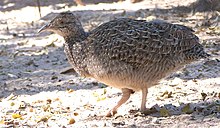Nothoprocta
| Nothoprocta | |
|---|---|

| |
| Brushland tinamou (N. cinerascens) | |
| Scientific classification | |
| Kingdom: | |
| Phylum: | |
| Class: | |
| Order: | |
| Family: | |
| Subfamily: | |
| Genus: | Nothoprocta |
| Species | |
|
Nothoprocta taczanowskii | |
Nothoprocta is a genus of birds belonging to the tinamou family Tinamidae. They inhabit scrubland, grassland and open woodland in western South America, particularly in the Andes. They are poor fliers and spend most of their time on the ground. Their diet includes seeds and insects. They nest on the ground, laying large glossy eggs. The eggs are covered with feathers when a potential predator is nearby.
They are medium-sized tinamous, 26 to 36 cm (10–14 in) long. They have strong legs and fairly long, downcurved bills. The plumage is mostly grey-brown with intricate black, white and buff markings. The birds have loud, whistling calls.
Species list
There are at least six species in the genus. A seventh species, Kalinowski's tinamou, Nothoprocta kalinowskii, is sometimes recognized but is more likely to be a junior synonym of Nothoprocta ornata branickii, a subspecies of the ornate tinamou.[1] The SACC voted to demote the Kalinowski's Tinamou, on 14 Feb 2007.[2]
- Nothoprocta taczanowskii, Taczanowski's tinamou, located in the Andes of south central Peru[3]
- Nothoprocta ornata, ornate tinamou, located in southern and central Peru, southwestern Bolivia, northern Chile, and northwestern Argentina[3]
- Nothoprocta perdicaria, Chilean tinamou, located in central Chile and west central Argentina[3]
- Nothoprocta cinerascens, brushland tinamou, located in southeastern Bolivia, northwestern Paraguay, and northern to central Argentina[3]
- Nothoprocta pentlandii, Andean tinamou, located in the Andes of northern and central Argentina, northern Chile, southwestern Ecuador, southwestern Bolivia, and western Peru[3]
- Nothoprocta pentlandii pentlandii located in western Bolivia, northwestern Argentina, and northern Chile[3]
- Nothoprocta pentlandii ambigua located in southern Ecuador and northwestern Peru[3]
- Nothoprocta pentlandii oustaleti located in central and southern Peru[3]
- Nothoprocta pentlandii niethammeri located in central Peru[3]
- Nothoprocta pentlandii fulvescens located in southeastern Peru[3]
- Nothoprocta pentlandii doeringi located in central Argentina[3]
- Nothoprocta pentlandii mendozae located in west central Argentina[3]
- Nothoprocta curvirostris, curve-billed tinamou, located in the Andes of southern Ecuador to northern Peru[3]
Etymology
Nothoprocta comes from two old words, nothos a Greek word meaning spurious or counterfeit, and prōktos meaning hindpart or tail. This combination of words probably has to do with the tail being small and covered with body feathers, therefore looking fake.[4]
Footnotes
References
- Clements, James (2007). The Clements Checklist of the Birds of the World (6 ed.). Ithaca, NY: Cornell University Press. ISBN 978-0-8014-4501-9.
- Gotch, A. F. (1995) [1979]. "Tinamous". Latin Names Explained. A Guide to the Scientific Classifications of Reptiles, Birds & Mammals. New York, NY: Facts on File. p. 183. ISBN 0-8160-3377-3.
- Krabbe, Niels & Schulenberg, Thomas S. (2005). "A mystery solved: the identity and distribution of Kalinowski's Tinamou (Nothoprocta kalinowskii)", Bulletin of the British Ornithologists' Club 125(4): 253-260<
- Mata, Jorge R. Rodriguez; Erize, Francisco & Rumboll, Maurice (2006). A Field Guide to the Birds of South America: Non-Passerines, HarperCollins, London.
- Perrins, Christopher, ed. (2004). The New Encyclopedia of Birds, Oxford University Press, Oxford.
- Remsen Jr., J. V.; et al. (14 Feb 2007). "Proposal (#246) to South American Classification Committee : Eliminate Kalinowski's Tinamou Nothoprocta kalinowskii from the list of South American species". South American Classification Committee. American Ornithologists' Union. Retrieved 4 Feb 2009.
